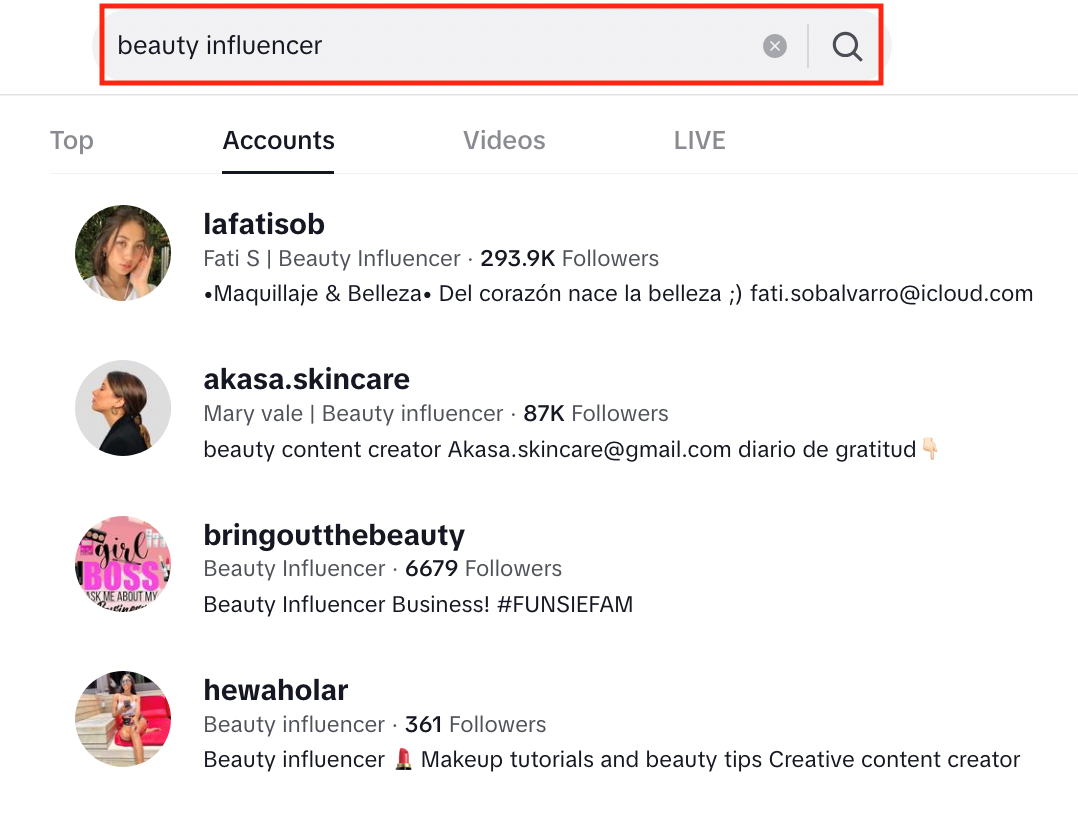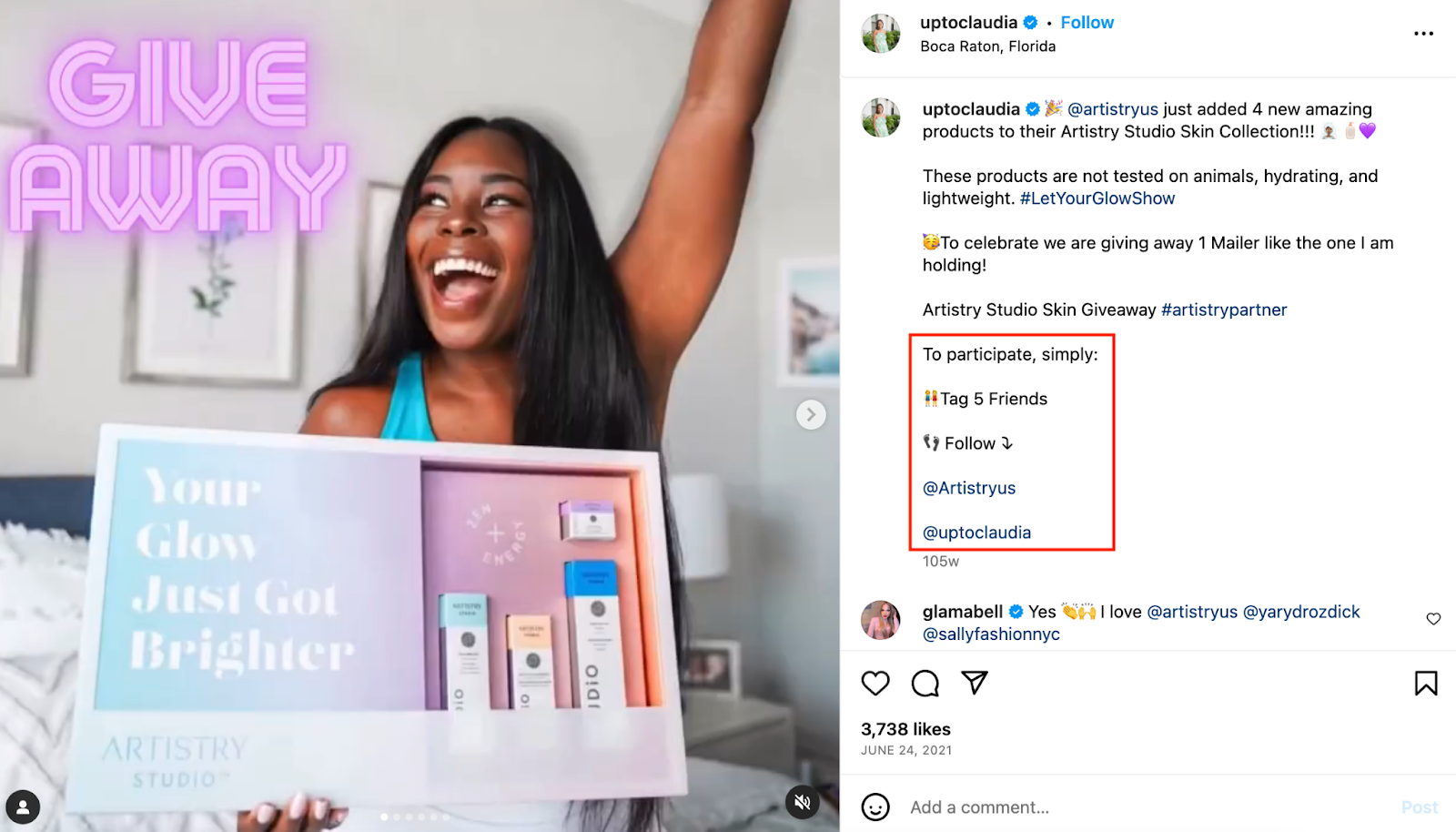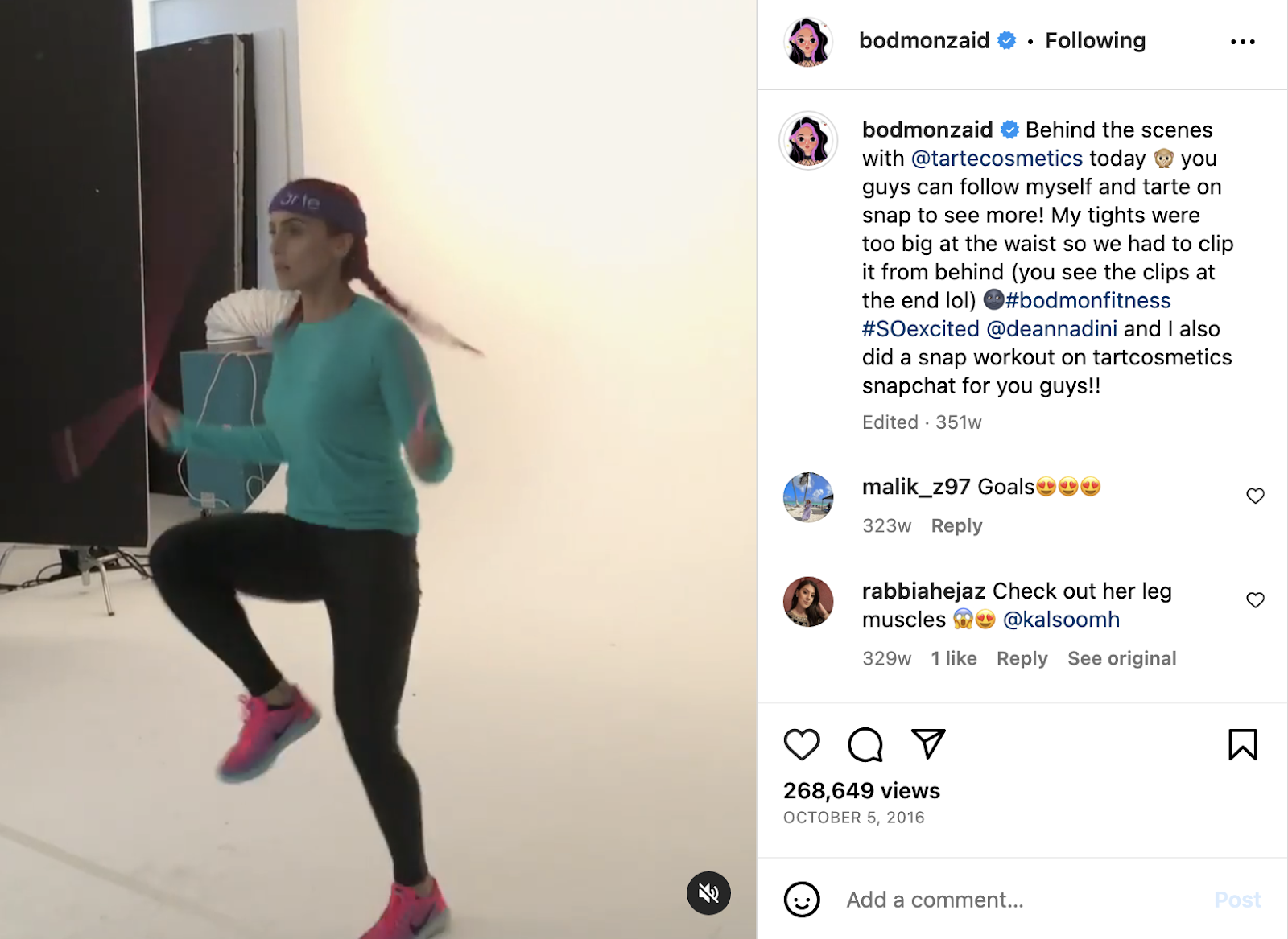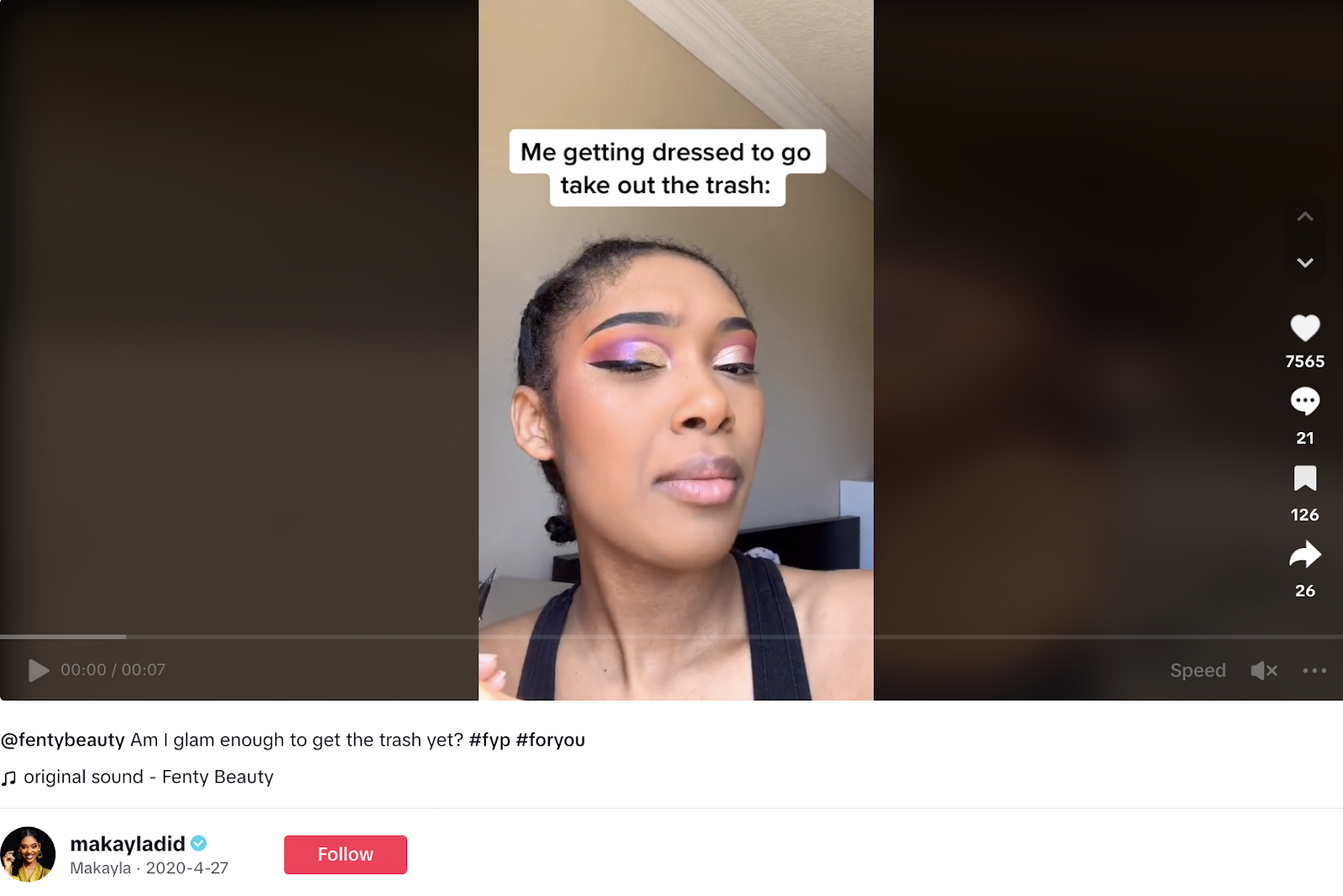Isle of Paradise tanning spray, Dr. Jart Cicapair color corrector, Eos shaving cream, and Elf concealer are just a few beauty products off the top of my head that have completely sold out because of their virality on TikTok.
Stores have dedicated "TikTok made me buy it" sections for consumers looking for products after watching them on a Reel or TikTok. All this to say, beauty influencers, while saturated, are also really effective — for both big brand names and small companies.
Here, we discuss:
- How you can find beauty influencers
- Persuading beauty influencers to collab with your brand
- Specific ways to collaborate with them
- Examples of excellent beauty influencer marketing campaigns
But first...
Think outside the "beauty box"
Beauty influencers aren't the only influencers you can collab with for a beauty brand.
Think about it: people who follow beauty influencers usually follow a lot of beauty influencers. That means their feed is chock full of beauty tips, tutorials, products (etc.). That's fine -- and you will make sales collaborating with those creators.
But... don't get stuck inside a box. Don't forget that there are other accounts, who don't usually create beauty content, but who still reach your target market.
Here's an example. @katieyovin is a creator with ~193k followers, who usually creates content around fitness and parenting.

A "typical" search process looking for beauty influencers probably wouldn't find her. She's not using beauty hashtags, and doesn't have anything beauty-related in the bio.
But Revela (a hair serum) had a successful collab with her:
.jpg)
This type of collab is more novel, and less common.
The influencer isn't used to receiving outreach from beauty brands, and their followers aren't bombarded with beauty products every third post in their feed.
Perhaps even more important, those influencers are likely not promoting your competitors.
Bottom line to keep in mind:
When choosing an influencer, the main thing that matters is the audience. If you're trying to reach women in the US aged 18-25 -- there are a ton of different creators who can do that. Not only beauty accounts.
Try experimenting with ~10-20% of your collabs with creators who aren't directly within the beauty niche.
How to find beauty influencers
With that out of the way, let's look at the actionable steps. *How* exactly can you find beauty influencers? Here's 5 methods -- some free, some paid.
1. Use an influencer discovery tool
The most efficient and data-driven way to find beauty influencers is to use a dedicated search tool like Modash. It lets you find creators, analyze their profiles, and monitor your campaigns.
Modash's database lists literally every creator with 1K+ followers (~250M+ creators) on TikTok, Instagram, and YouTube. In every niche, every city, every country. You can apply filters to refine your search, including follower range, location, gender, age, bio keywords, and hashtags.
I'll show you in <2 mins how brands use Modash to find beauty influencers.
Note: this method works equally well for Instagram, TikTok, and YouTube -- but I'll demonstrate by finding Instagram influencers in this example.
Influencer filters
Once inside Modash, you'll land on the Discovery tab.
Apply the influencer filters to get a list of creators who check every box you need. Start with just a few base filters. For example:
- A follower range, depending on your budget and goals (e.g., 5k-50k)
- “Has email” as a criterion, to only get results with a public email available
- Creator/regular accounts only (to remove businesses)
- One way to identify your beauty niche (e.g., “skincare” in bio)
Don’t start adding other filters like minimum growth or engagement rates yet. Let’s see how the pool looks first, then maybe narrow it down further later if we still have many options.

If you have a niche within beauty, specify it using bio keywords or hashtags. For example, if you’re focused on skin concerns like acne or eczema, add these keywords to see how the results compare.
Do some trial and error too -- think about what your ideal creator might write in their bio.
(And, don't forget to try some outside-of-the-box ideas too!)
Audience filters
You can also apply audience filters to further specify who you're trying to reach. Some audience filters you can apply include location, age, gender, fake followers, and interests.
Again, start with the minimum possible filters. For example, if you’re only looking for female audiences in the US — just start there. We can always come back and narrow further later (e.g., age, interests) — we don’t want to restrict the search too much and miss great creators.

✅ Pro-tip: Apply filters one by one instead of all at once to avoid potentially missing out on influencers who might be a good fit.
Analyzing profiles
After you run your search, Modash will give you all the profiles that match your filters. Click on a profile to see data on everything from performance metrics (engagement rate, average views), audience demographics (age, gender, locations), top content & sponsored posts, and audience credibility.
.jpg)
If you click "Save" to add a profile to your shortlist, you can also find their email in one click for outreach later.

Continue adding more filters, keep changing the keywords and hashtags, and experiment with the specific percentages of different filters to look for different creators.
You can try Modash for free; no credit card needed 🙂
2. Create a brand ambassador program
Brand ambassador programs are a great way to work with influencers long-term, and there are tons of successful examples in the beauty industry.
From Sephora's Squad to Glossier's Reps and Morphe's Babes. Or, for a beauty ambassador program example that's a little more relatable than the huge brands like Sephora, check out Wild: https://www.wearewild.com/pages/ambassador-programme.
Wild have scaled to a team of ~20 influencer marketers, with creator partnerships being their top revenue-generating channel.
They use performance-based commission payments, discount codes, and drive inbound interest via a landing page & application form.
.jpg)
To create a brand ambassador program, start with a landing page that has all the information on how to apply, eligibility criteria, and other necessary details. The landing page will help you get inbound traffic and make it easier for influencers to find your program by typing ‘your brand name + brand ambassador program.'
To kickstart applications, be sure to share the details of your program on social media accounts and through other distribution channels you use (newsletter, blog). Add a link in your website footer, too.
3. Search directly on social media
Instagram, TikTok, and YouTube are great places to find beauty influencers and reach out to them.
Search with hashtags or keywords
You can find relevant content creators using hashtags relevant to the beauty industry, like #makeuptutorial, #makeupinfluencer, and #beautyinfluencer. Try to use more specific hashtags like #beautyproductsreview or #skincareproducts.

To find relevant creators quickly on social media, search using keywords like 'beauty influencer,' and the platform will show you profiles with the targeted keyword in their username.

Try the 'Explore' and 'For You' tabs
Instagram's 'Explore' page, TikTok's 'For You,' and YouTube’s ‘Explore’ tab are the perfect place to find relevant creators that might fit your brand. Use your brand account to watch beauty-related posts to train the algorithm to show you relevant content and influencers.

The major downside of this method (and the next one) is that:
- It's manual & time consuming
- You don't get much data pre-outreach (e.g. audience demographics) to make good decisions
That said, if you're on a shoestring budget those tactics can get you started.
4. Search on Google
Google is a great way to find beauty influencers. Just type "beauty" with terms like "influencers" or "creators," and you will find lists of relevant influencers.
Though -- you'll probably only find huge celebrities, so try to be more specific.
You can find curated lists or recent articles featuring beauty influencers by adding extra words like "micro" or a city/country. For example "Berlin beauty influencers" already yields some much more relevant results.

5. Look for people who already love your brand
Some of the best collabs will come from people who already love and use your products.
You could find them in a few different ways.
Check brand mentions
Many nano and micro-influencers tag brand accounts whose products they already use and want to partner with. You can keep track of all the 'Tagged' photos by going to your profile. If the content you see is high-quality, reach out to the influencer.

Check your brand account for influential followers
Modash has a feature that surfaces any influential followers you might have in just a few clicks.
- Go to Modash's Discovery tool
- Click "Find your fans" and enter your account username
- Click "Show profiles"

Those people are going to be excited to receive outreach from you, and eager to collaborate.
Persuading a beauty influencer to work with your brand
The beauty influencer space is very saturated -- and creators' inboxes are filled with rubbish. After shortlisting influencers, it's time to do to the hard part. Convincing them to promote your products.
Here're a few tips to nail your outreach:
1. Personalization is everything
Even at smaller follower counts, a creator can smell a template a mile off.
If you're a recognizable brand that is desirable to work with, templates will probably work.
But if you're earlier in your brand's journey with less awareness, you're going to have to work extra hard to get responses to your recruitment emails.
Here’s an example that beginners think is personalization, but in reality could be sent to almost any creator, and is utterly ignorable:
Hi Sarah,
I stumbled across your profile on TikTok and was blown away by the quality of content and the amazing detail you go into for every post.
[Company pitch here]
Getting someone’s first name and a generic insincere compliment is not enough.
Here’s an example of actually good personalization:
Hi Sarah,
Your story about cystic acne was super relatable. I struggled with it for years, and I really wish I could've seen your post 10 years agoI
I'm Sarah from XYZ Skincare -- we have a big focus on cruelty-free vegan products, especially for sensitive skin like ours.
Your style and values really align with mine, and I think you'd be a perfect partner for us.
Can I send you more info about what I have in mind?
Key points to take note of:
- The sender has clearly actually seen the creator’s content
- The products are clearly relevant to the content
- It uses a “soft ask” (all you need is a “yes”, and the conversation is started)
📝Learn more: Influencer Outreach Guide
2. Reassure the creator that they have creative freedom
Brands who have overly strict guidelines are less desirable to work with.
Influencers value their creative freedom -- and if they do work with a brand, they want to do it their way.
Their followers follow them for a reason, and you don't want your collab to be labelled a "sell out" because it's so far away from the usual style.
Yes, give examples of what you like & what worked well in a brief (later). But initially, just reassuring the creator that you're open to a variety of creative styles & open to discussing ideas will increase your response rate.
3. Be clear about the incentives and perks available
Remember that when anyone receives an outreach email (not just creators), they're thinking "what's in it for me?"
So make sure that's clear up front.
If you're offering payment up front, say it. If you'll offer free products, discounts, VIP access to something, say it.
If there's the potential for recurring payments every month, put that on the table.
The clearer you are about what you're offering (assuming it's actually attractive), the higher your response rate will be.
How to collaborate with a beauty influencer
There are various ways to collaborate with influencers, depending on your brand goals, budget, and the influencer's preferences.
For most beauty brands, their influencer spend will be a mixture of sponsored posts, affiliate commissions, and product seeding. They're all interlinked -- but here's what I think most beauty brands should start with.
First, set up an affiliate program
You can set up an affiliate program where the influencer promotes your products or brand using unique discount codes or affiliate links. They earn a commission for every sale generated through their platform or using their code, providing them with an ongoing incentive to promote your products.
You might have learned that most creators aren’t keen on commission-only deals. It adds risk and unknowns, and they'd prefer upfront payment.
So why start here, regardless?
1- You need the opportunity to add performance-based elements to other collabs (more on this later).
2- Your existing customers and fans can discover the program and get started on their own. Once set up, it’s very low effort to maintain.
So, you've set up an affiliate program. Customers & fans can find it and get started self-serve, but you don't expect many more inbound leads at this stage.
So where to start with outbound influencer recruitment?
Sponsored posts are your go-to if you have a budget to work with
Sponsored posts are a paid collaboration with an influencer and your brand. There are multiple ways to pay your influencers, and one is to pay per post.
Sponsored posts should always include ad disclosures with either an #ad hashtag or be posted under "Paid Partnership" to meet FTC guidelines.
Why are these posts better?
- They guarantee results (content posted). You don't just cross your fingers and hope for Stories to appear.
- Brands have more control over the sponsored content and can ensure that key messages are conveyed.
- Your outreach will be more successful. More creators will respond to your emails because you’ll offer money upfront.
Here's an example -- Natrium Skin partnered with Makeup By Scott to promote its viral lip balms in the UK.

And, remember that affiliate program?
Now, you can add a performance-based element to take the collab further.
You've already paid up front. That guarantees the collab happens, and builds some trust. But now you can incentivize the creator to try a little harder, do a little more, and post additional content with performance-based pay,
They can also optimize their ability to drive traffic over time and increase their earnings.
If it’s a great fit, they’ll keep posting even after the sponsoring post collaboration is done to increase their affiliate revenue.
Do product seeding if you have a low budget but more time
Product seeding is a low-cost but time-intensive method to generate content and start new influencer relationships.
The process goes something like this:
- Identify and select influencers
- Send free samples of your products to small creators without asking for anything in return
- (Optional) Ask (or pay) for permission to repurpose the content (e.g., Meta ad creatives or Spark Ads)
- Recruit the most engaged creators onto performance-based partnerships
The cost of product seeding is just the cost of your product and shipping, plus maybe some software costs for finding influencers and sending outreach emails. The biggest cost (creator payments) is removed.
Then, time for the affiliate program again.
Those creators who posted about your product? Recruit them onto a revenue share model. Incentivize them to try harder to sell your product — and to post more beyond that initial thank-you/unboxing post.
If a creator has already posted once, chances are that:
- They actually like the product, and
- They’ll be more open to posting again with a revenue share commission-only model
Your success rate will be higher this way vs. starting your cold outreach with a commission-only offer right from the start.
Solawave, a skincare tool company, gifted its Advanced Skincare Wand to Rachel, a travel and lifestyle influencer. The brand also gave her a discount code to share with her followers.

3 more ways you can collab with beauty influencers
Giveaways and contests
Collaborate with an influencer to host a giveaway or contest on their platform. The influencer will promote it to their audience while your brand provides the products — in exchange for a desired action like following your account, commenting on your post, or tagging their friends.
Best for
- Increasing brand awareness
- Getting higher engagement
- Encouraging the audience to follow your account
What it looks like
Artistry US, a makeup and skincare brand, collaborated with influencer Claudia Caminero to host a giveaway. The instructions to enter the giveaway were quite simple — tag five friends and follow both the brand's and influencer's accounts.

Product launch collab
Beauty influencers can help you spread the word about your new product. A product launch collab can include exclusive content, early access, and sneak peeks of the product to their followers.
Best for
- Increasing awareness about a new product
- Creating buzz and curiosity
What it looks like
Bliss, an accessible skincare company, launched its Clear Genius product line in 2020 amidst the pandemic. The brand worked with multiple TikTok influencers to spread the word about the new collection through the hashtag challenge #ThisIsBliss — which got 6.78 billion views.
Every product in the launch instantly became a best-seller, selling 4,748 units on Bliss's website in the first 60 days.

Co-creating products with influencers
You can collaborate with the influencer on developing a co-branded skincare line, foundation collection, or limited edition lipsticks.
The influencer can provide their input on the design, packaging, and marketing — depending on the influencer contract. This type of collaboration will work best with mega-influencers or celebrities as they have a dedicated following, and people look up to them.
Best for
- Create a unique and exclusive selling point
- Strengthening partnerships with huge influencers
What it looks like
Tula, a probiotic-based skincare brand, launched its #EmbraceYourSkin initiative led by five major influencers — Tess Holliday, Tennille Murphy, Nyma Tang, Chizi Duru, and Weylie Hoang.
Each influencer curated their limited-edition #EmbraceYourSkin kit with existing Tula products targeting a skincare concern, such as hydrating, clarifying, exfoliating, brightening, and ageless skin.

3 examples of beauty influencer marketing campaigns
Let’s look at what successful beauty influencer marketing looks like in action through the following three examples.
1. #CurologyJourney
Curology, a skincare brand, launched its #CurologyJourney campaign to celebrate its community and shine a light on some of its users.
The campaign included multiple videos on YouTube highlighting each user's skin concerns and experiences before and after using Curology products.
While Curology highlighted its users, the campaign also included influencers like Haille Bingaman, an artist who had used the brand's products for her cystic acne for years.

🎊Campaign results
- 800K+ social impressions
- 82K+ social engagements
- 312K+ video views
- 2,650 posts on Instagram tagged with #CurologyJourney
One of the comments received on a video included, "....props on using a person with actual acne and not actors with perfect skin already”.
💡Key takeaways
- Put the spotlight on your consumers and share their experiences with your brand to get the audience to connect with you.
- You don't have to partner with bigger or more famous influencers. Working with smaller influencers and focusing on genuine content and storytelling will do the work.
2. #HustleAndGlow with athleisure skincare collection
Tarte Cosmetics launched its athleisure skincare collection for athletes and gymgoers.
The campaign #HustleAndGlow focused on "sporty as the new sexy" and collaborated with a fitness influencer Laiba Zaid. With over 1.2M followers who follow her for workout advice and are gymgoers themselves, Laiba's audience made her the perfect influencer for Tarte's new skincare collection.

🎊Campaign results
Tarte's Cosmetics launched the first-ever athleisure-focused collection, and the results were enormous, including:
- 196M social impressions
- 78M media impressions
- 1.6M measurable social engagements
- 219K total video views
💡Key takeaways
- Looking outside your core niche helps put your brand in front of a different demographic
- Focus on what's important to your target audience and create messaging around that
3. Fenty Beauty's collab house
Fenty Beauty, a cosmetics brand founded by the singer Rihanna opened a first-of-its-kind collab house in 2020.
A collab house is a dedicated place for influencers to come together, create content, and collaborate on each other's content.
The brand collaborated with five TikTok mega-influencers, including professional makeup artists Emmy Combs, Makayla, Savannah Palacio, Challan, and Dawn. These influencers produced humorous videos showing Fenty's products, giving a behind-the-scenes look at the collab house and tutorials on the products.

🎊Campaign results
Within three weeks,
- #FentyBeautyHouse hashtag had over 10 million views
- #FentyBeauty had over 44 million views on TikTok
- The brand's TikTok audience grew by 1180% in a week.
Fenty's collab house resulted in massive media outlets covering the story, including Vogue, Time, Harper's Bazaar, Glamour, Billboard, and W Magazine.
💡Key takeaways:
- While influencers should create content relevant to your campaigns, they should also entertain your audience.
- Fenty's influencer content focused on diversity and inclusion outside of makeup and cosmetics — showing the audience the brand has strong values.
📝Learn more: 9 Ways To Collaborate With Influencers
Ready to take your beauty influencer marketing to the next level with Modadsh?
Influencer marketing is already quite saturated for beauty brands.
But if you start today, after a year, you’ll have created ~100+ ROI-positive partnerships and turned influencers into one of your top revenue-generating channels.
When you’re ready to scale up recruitment, try Modash. It has everything you need to find your next 1,000+ perfect-fit fashion creators:
- Search & filtering
- Audience & performance data (without reaching out)
- Finding email addresses
- Monitoring content
- … and more
Try it for free today! (no credit card needed)











